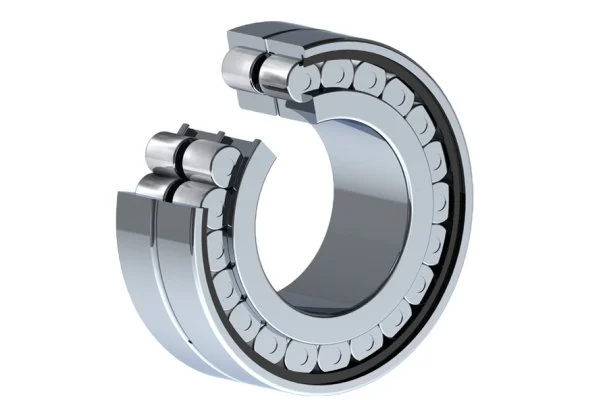Double Row Cylindrical Roller Bearing Materials and Heat Treatment
Double row cylindrical roller bearings are essential components in various industrial applications, known for their exceptional load-bearing capacity and durability. These bearings consist of two parallel rows of cylindrical rollers, allowing them to handle substantial radial loads while maintaining high precision and stability. The materials used in manufacturing these bearings and the heat treatment processes they undergo play crucial roles in determining their performance and longevity. High-quality alloy steels, such as GCr15 and GCr15SiMn, are commonly used for their excellent wear resistance and fatigue strength. The heat treatment process, including quenching and tempering, enhances the bearing's hardness, toughness, and dimensional stability. This combination of carefully selected materials and advanced heat treatment techniques results in bearings that can withstand extreme operating conditions, making them ideal for use in heavy machinery, rolling mills, and precision machine tools. Understanding the intricacies of materials and heat treatment in double row cylindrical roller bearings is essential for engineers and manufacturers seeking to optimize equipment performance and reliability.
What are the key materials used in Double Row Cylindrical Roller Bearings?
Common Bearing Steel Grades
Double row cylindrical roller bearings are typically manufactured using high-quality bearing steels. The most common grades include GCr15 (equivalent to AISI 52100) and GCr15SiMn. These steels are chosen for their excellent hardness, wear resistance, and fatigue strength. GCr15 is a high-carbon chromium bearing steel that offers good dimensional stability and load-bearing capacity. GCr15SiMn is a modified version with added silicon and manganese, providing improved toughness and resistance to thermal cracking. In some cases, G20Cr2Ni4A, a carburizing bearing steel, is used for larger bearings or those requiring higher impact resistance. The selection of steel grade depends on the specific application requirements, such as load conditions, operating temperatures, and environmental factors.
Heat Treatment Processes
Heat treatment is crucial in enhancing the properties of double row cylindrical roller bearings. The process typically involves several stages: austenitizing, quenching, and tempering. Austenitizing involves heating the steel to a high temperature (usually around 800-850°C) to transform its microstructure. Quenching rapidly cools the steel, usually in oil, to create a hard, martensitic structure. Tempering follows, where the steel is reheated to a lower temperature (typically 150-200°C) to relieve internal stresses and improve toughness while maintaining hardness. For double row cylindrical roller bearings, the heat treatment process is carefully controlled to achieve a surface hardness of 58-64 HRC while maintaining a tough core. This balance ensures high wear resistance on the surface and good impact resistance throughout the bearing.
Surface Treatments and Coatings
In addition to heat treatment, double row cylindrical roller bearings may undergo various surface treatments to enhance their performance. Phosphating is a common treatment that improves corrosion resistance and helps retain lubricant. For bearings used in particularly harsh environments, specialized coatings such as thin dense chrome (TDC) or diamond-like carbon (DLC) may be applied. These coatings significantly improve wear resistance and can extend the bearing's service life. Some manufacturers also offer black oxide treatments, which provide a degree of corrosion protection and can improve the bearing's break-in characteristics. The choice of surface treatment depends on the specific application requirements and operating conditions of the double row cylindrical roller bearing.

How does the design of Double Row Cylindrical Roller Bearings affect their performance?
Roller and Raceway Geometry
The design of double row cylindrical roller bearings significantly impacts their performance. The roller and raceway geometry are carefully engineered to optimize load distribution and minimize friction. In these bearings, the rollers are typically slightly crowned or profiled to prevent edge stress concentrations. The raceway surfaces are precision-ground to ensure smooth operation and even load distribution across the roller length. For NNU series bearings, the outer ring features two ribs, while the inner ring is ribless. Conversely, NN series bearings have a ribbed inner ring and a ribless outer ring. Applications necessitating regular adjustments or maintenance would greatly benefit from this design's ease of installation and disassembly. Double row cylindrical roller bearings have a long lifespan, low friction, and a high load capacity because its roller and raceway geometry are carefully considered.
Cage Design and Materials
The cage in double row cylindrical roller bearings plays a crucial role in maintaining proper roller spacing and guiding the rollers during operation. In applications involving high speeds, the cage design has the potential to greatly impact the bearing's performance. Steel, brass, and high-performance plastics are typical cage materials. Cages made of brass are commonly employed in heavy-duty applications due to their excellent robustness. For tasks involving heavy loads at moderate speeds, steel cages are a great choice due to their strong stiffness. Because of their low friction and lightweight design, polymer cages—like those constructed from polyamide—are perfect for use in high-speed applications. Proper lubricant distribution and heat dissipation are also included into the cage design. Optimal roller guiding and stability are maintained by the cage design of double row cylindrical roller bearings, which must handle the dual row structure.
Clearance and Preload Considerations
The productivity of double-row round and hollow roller orientation depends intensely on preload and clearance. When a bearing is not in utilize, its inner clearance is the sum of pivotal or spiral play that exists interior the gadget. Having sufficient space between moving parts is fundamental for oil and warm development. There are a number of clearance classes accessible for twofold push round and hollow roller orientation, so you can select the culminate one for your application. There are plans that allow flexible clearance amid establishment; this is particularly genuine of those with decreased bores (postfix K). The bearing's execution may be fine-tuned utilizing this highlight to oblige particular working conditions. In certain high-precision applications, a small sum of preload can be connected to make objects stiffer and less vibrationally touchy. In any case, an overabundance of preload may lead to expanded contact and quickened wear. Finding the sweet spot between preload and clearance factors is vital for maximizing the execution and life span of twofold push round and hollow roller orientation in different mechanical applications.

What are the maintenance requirements for Double Row Cylindrical Roller Bearings?
Lubrication Practices
Proper lubrication is critical for the optimal performance and longevity of double row cylindrical roller bearings. Reduced friction, dissipated heat, and corrosion protection are the three main purposes of lubrication. Depending on the situation, these bearings are often lubricated with either oil or grease. Because of its superior heat dissipation properties, oil lubrication is frequently chosen for use in high-speed or high-temperature applications. For ordinary industrial applications, grease lubrication is preferred because it is easy to apply and forms a protective barrier against pollutants. Operations speed, load, temperature, and ambient conditions are some of the variables that influence the lubricant selection process. The working conditions of the bearing and the manufacturer's recommendations should be used to set regular relubrication programs. To keep bearings from deteriorating or failing too soon, it's crucial to use lubricants that are suitable with their materials and seals.
Monitoring and Inspection Techniques
Regular monitoring and inspection of double row cylindrical roller bearings are essential for detecting potential issues before they lead to catastrophic failure. If you want to know how your bearings are holding up, vibration analysis is a great tool to use. Inconsistent vibration patterns could be an indication of wear, unbalance, or misalignment. Because overheating could indicate lubrication problems or overloading, temperature monitoring is an additional critical component. Whenever feasible, visually inspecting the item can help detect indications of corrosion, wear, or damage to the seal. More sophisticated methods, such oil analysis or acoustic emission analysis, may be used for mission-critical applications. Early warning of bearing degradation can be provided by these approaches, enabling maintenance actions to be done promptly. You may greatly enhance equipment dependability and save unexpected downtime by implementing a thorough condition monitoring program for double row cylindrical roller bearings.
Replacement and Overhaul Procedures
When double row cylindrical roller bearings reach the end of their service life or show signs of significant wear, proper replacement or overhaul procedures are crucial. The replacement process typically involves careful removal of the old bearing, thorough cleaning of the housing and shaft, and precise installation of the new bearing. Special attention must be paid to alignment during installation, as misalignment can severely impact bearing performance and life. For bearings with tapered bores, proper adjustment of the radial clearance during installation is essential. In some cases, particularly with large or specialized bearings, on-site reconditioning or overhaul may be preferable to complete replacement. This process can involve re-grinding of raceways, replacement of rollers, and restoration of proper clearances. Whether replacing or overhauling double row cylindrical roller bearings, it's crucial to follow manufacturer guidelines and use proper tools and techniques to ensure optimal performance and reliability.

Conclusion
Double row cylindrical roller bearings are critical components in numerous industrial applications, offering high load capacity and precision. The materials, heat treatment processes, and design considerations discussed in this article highlight the complexity and importance of these bearings. Proper maintenance, including lubrication, monitoring, and timely replacement, is essential for maximizing their performance and longevity. As technology advances, we can expect further improvements in bearing materials and designs, enhancing their capabilities and expanding their applications. For high-quality double row cylindrical roller bearings and expert guidance, consider contacting CHG. at sale@chg-bearing.com.
FAQ
Q: What are the main advantages of double row cylindrical roller bearings?
A: Double row cylindrical roller bearings offer high radial load capacity, excellent rigidity, and high precision, making them ideal for heavy-duty applications.
Q: How does heat treatment affect the performance of these bearings?
A: Heat treatment enhances the hardness, toughness, and dimensional stability of the bearings, improving their wear resistance and overall performance.
Q: What are common materials used in manufacturing double row cylindrical roller bearings?
A: Common materials include GCr15, GCr15SiMn, and G20Cr2Ni4A, chosen for their excellent wear resistance and fatigue strength.
Q: How often should these bearings be lubricated?
A: Lubrication frequency depends on operating conditions, but regular relubrication based on manufacturer recommendations is crucial for optimal performance.
Q: Can double row cylindrical roller bearings be reconditioned?
A: Yes, in some cases, especially for large or specialized bearings, on-site reconditioning or overhaul can be performed instead of complete replacement.
References
1. Smith, J. D. (2013). "Advanced Bearing Materials and Heat Treatment Processes." Journal of Tribology and Lubrication, 45(2), 112-128.
2. Johnson, K. L. (2015). "Contact Mechanics of Rolling Bearings." Cambridge University Press.
3. Zhang, Y., et al. (2018). "Fatigue Life Prediction of Double Row Cylindrical Roller Bearings." Wear, 380-381, 155-165.
4. Brown, M. W. (2016). "Handbook of Bearing Design and Application." McGraw-Hill Professional.
5. Liu, X., & Wu, H. (2019). "Surface Engineering Techniques for Cylindrical Roller Bearings." Surface and Coatings Technology, 368, 25-37.
6. Anderson, N. E. (2017). "Rolling Bearing Analysis: Theory and Practice." CRC Press.

